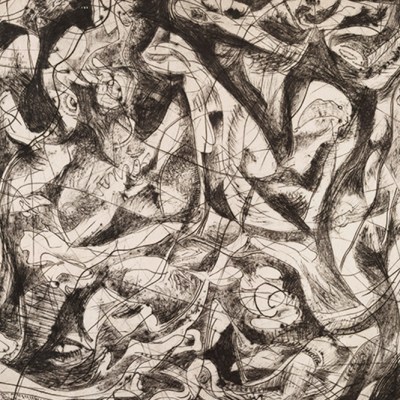For Clement Greenberg, the history of painting was a matter of trajectory. Art’s progress from the illusionary pictorial space of the Renaissance, through the fragmentation of modernism, culminated inexorably in abstraction – ‘the dissolution of the pictorial into sheer texture’, as he described it. It has long been customary to dismiss Greenberg’s vision, which established the Ab-Ex movement (especially Jackson Pollock) at the zenith of art history, as passé; since the 1980s, we’ve become familiar with using other tools, such as social history, to think about the evolution of form. But every so often one encounters a painting that serves as a reminder of how fundamentally Greenberg’s ideas have shaped the way we think and look.
Before Sotheby’s Modern and Contemporary evening sale on 1 March, I spent a few moments standing in front of Wassily Kandinsky’s Murnau mit Kirche II (Murnau with Church II; 1910) – the auction’s headline lot – conducting an experiment. I tasked myself with looking at the painting solely on its own terms – not thinking about trajectory, that is.
I made myself notice the way that the spire of the church dominates the landscape, its leaning vertical rhyming with the contours of the sheer mountains behind. I thought about the ways that the cool blue of the Alpine sky gives way to the blood-red of what might be the sun creeping in at top-right, and the way these warm and cold colours are refracted across the roofs of houses and the hills they nestle between.
Murnau mit Kirche II (Murnau with Church II) (detail; 1910), Wassily Kandinsky. Sotheby’s London.

But before long, it became impossible not to allow the mind to further fragment the jumble of curves and lines – to remember that, in short order, Kandinsky would abandon all attempt at reference to reality, and to see this painting as a waymark on the route to this moment. Giving in to this kind of looking holds its own, particular pleasure. It is probably this clear sense of its position on the road to abstraction that contributes most of all to the painting’s power.
Perhaps this feeling was shared by the anonymous guarantor who paid £37.2m for the painting on Wednesday night – setting a new record for the artist by beating the £29.2m set at Sotheby’s in 2017. That figure was achieved for Bild mit weissen Linien (Painting with White Lines), painted in 1913 – the year Kandinsky broke free from representation entirely. It is interesting that the auction record is now held by a transitional work, rather than one of full-blooded abstraction. Ahead of the sale, Sotheby’s marketing for the picture made much of its position at the ‘very beginnings of the revolutionary abstract language that would underpin the rest of Kandinsky’s career’.
Dans på stranden (Reinhardt-frisen) (Dance on the Beach (The Reinhardt Frieze)) (1906–07), Edvard Munch. Sotheby’s London.

But of course, there are always multiple factors at play in the arcane science of establishing value at these upper reaches of the art market – and there are other stories to this painting. The painting was acquired soon after it was painted by Johanna Margarete Stern and Siegbert Samuel Stern, textile merchants and collectors who became leading socialites in Weimar Berlin, counting among their friends Thomas Mann, Kafka and Einstein. Siegbert died in 1935, and Johanna Margarete fled Nazi Germany in 1937 for the Netherlands, where she was forced to disperse her collection; she died in Auschwitz in 1944. The Kandinsky entered the collections of the Van Abbemuseum in Eindhoven in 1951, where it remained, its provenance unnoticed, until 2013. After a protracted legal battle, the museum finally agreed to restitution last year – overturning a decision by a Dutch court in 2018. Proceeds from the sale will be shared among the 13 surviving Stern heirs, while also funding provenance research into the fate of the dispersed Stern collection. With apologies to Clement Greenberg, perhaps Murnau mit Kirche II has become as much an artefact of social history as a work of art.
The Kandinsky was top lot in a solid sale of 58 lots, which made a total of £147m. Gerhard Richter’s Abstraktes Bild (1986) made £20m, while another restituted work, Edvard Munch’s four-metre-long Dance on the Beach (1906–07) – the only part of the spectacular frieze Munch completed for the theatre director Max Reinhardt to remain in private hands – achieved £16.9m.
The previous night, Christie’s brought in a total of £106.1m – near the low estimate – for its 20th and 21st century offering, and a further £31.7m for its ‘The Art of the Surreal’ sale the same evening. Picasso’s portrait of Jacqueline Roque, his second wife, was the top lot, but fell just below its low estimate at £14.5m. But perhaps the most interesting piece was a portrait from Van Gogh’s earthier Dutch period, depicting Gordina de Groot – a farmworker who also crops up in The Potato Eaters (1885), and who is rumoured to have been the painter’s lover and the mother of his child; it sold to the dealer Danny Katz for £4m, twice its top estimate. It was a sorry day for Ernst Ludwig Kirchner; two works by the German Expressionist, a ragged, angular portrait (estimate £2.4m–£4m) and an undulating landscape (estimate £1.6m–£2.5m) failed to find buyers. But among the contemporary works at Christie’s there were records for Caroline Walker and Michaela Yearwood-Dan. The spring season underway, eyes now to turn to New York for the Asia Week marquee sales in just over a fortnight’s time.
Kop van een vrouw (Gordina de Groot) (Head of a Woman [Gordina de Groot]) (1885), Vincent Van Gogh. Christie’s, London




